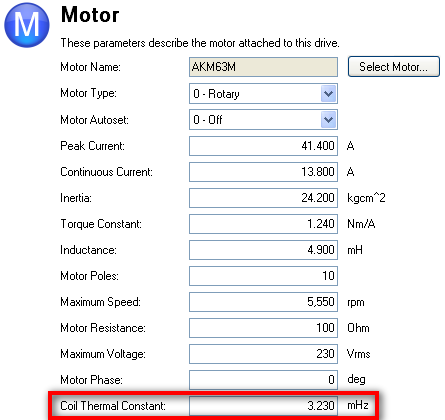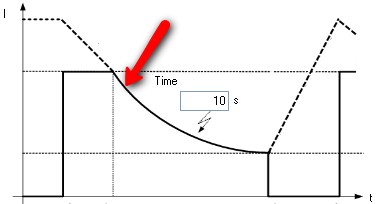Coil Thermal Constant (MOTOR.CTF0)
The Coil Thermal Constant, along with the peak current setting, determines the rate of change of the decrease in motor current during a foldback condition. When creating a custom motor in Workbench, you will need to know the Coil Thermal Constant. Since this parameter is not listed on most motor datasheets, you can calculate it using the formula below.


Coil Thermal Constant in mHz:
MOTOR.CTF0 = 1000 / (2 * PI * "Bulk Motor Thermal Time Constant in sec" / "Thermal Time Constant Ratio")
For Kollmorgen AKM motors, the ratio can be assumed to be 30:1 (meaning the coil thermal time constant is 30 times faster than the bulk motor thermal time constant).
MOTOR.CTF0 = 1000 / (2 * PI * "Bulk Motor Thermal Time Constant in sec" / 30)
Detailed Explanation:
There are two thermal time constants of interest in a motor. One is the bulk or whole motor thermal time constant. This time constant is typically measured by running the motor at rating until full/steady state temperature rise and then watching the temperature fall. The falling curve gives the bulk thermal time constant and is mostly determined by the mass of the stator and heat sink plate the motor mounts to. This time constant is the one you usually see on motor data sheets.
The second thermal time constant of a motor is the time constant to raise the temperature of the just the motor winding and not the rest of the motor. When you run a motor at say 3*Icont and get 9 times the I^2*R resistive heating compared to Icont power, then the motor winding heat stays trapped in the copper at first before it conducts away to the rest of the motor. Since the mass of copper is much smaller than the mass of an entire motor the initial rise of temperature in the copper can be quite fast compared to the overall bulk motor. The MOTOR.CTF0 should match up with the motor winding/coil and not the motor bulk thermal time constant. Unfortunately, the motor coil thermal time constant is rarely listed on a motor data sheet. Some motor data sheets do list the mass of copper in the winding and the coil thermal time constant can be estimated from that. However, that analysis and formula is beyond this short explanation.
The accurate way to calculate a motor’s coil thermal time constant is to know the mass of copper in the winding and a little about the internal temperature rise distribution inside the motor. In absence of any information about the coil copper mass, the coil thermal time constant can be estimated to be at least 10 times faster and up to 30 times faster than the bulk motor thermal time constant. All Kollmorgen AKM (1st Gen) motors are in the 20x to 30x range for the ratio of the two thermal time constants.







 Home >
Home > Knowledge Base >
Knowledge Base > Community >
Community > Downloads >
Downloads >